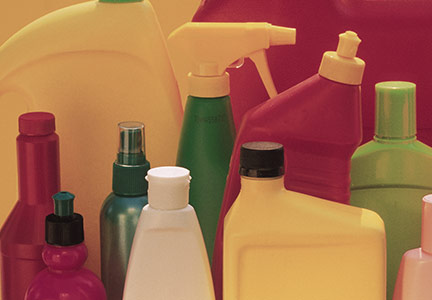Chemical preservatives are used in a great number of everyday household products. They are found in food, soap, cosmetics, air fresheners, and even cleaners. Despite their prevalence, preservatives are some of the most poorly understood chemicals in the home. This article describes the role preservatives play in a product's life cycle, where preservatives are found, and how manufacturers choose preservatives and set preservative levels.

Most people don't know that the fundamental principles of food preservation also apply to other household products such as cleaners, air fresheners, and cosmetics, so food is a great place to start a discussion about preservatives.
After food is made or cooked, microbial populations are very low. As everybody knows, if food is left at room temperature, dangerous microorganisms can grow inside. If a harmless microorganism is present, growth in the food results in spoilage (changes in appearance or smell) but not increased risk if ingested. If a harmful microorganism or pathogen is present then growth in the food can result in infection if the food is eaten.
Refrigeration slows microbial growth but does not stop it, so food makers turn to preservative chemicals to increase shelf life, the time a product can be stored before its appearance, function, or safety changes. Thus, the purpose of chemical preservatives in food is to stop microbes from growing when conditions are otherwise right. The same principles apply to a host of other household products, so the purpose of a preservative in any product is to slow or stop microbial growth.
Microbes love water, food, and neutral pH (not too acidic). If a product has all these characteristics, then it will spoil quickly without preservatives. It doesn't matter to a microbe if a product is a food, a cosmetic, or a cleaner. If conditions are right and the microbe can consume the substance, it will! Accordingly, manufacturers of household products incorporate preservatives to extend shelf life and protect consumers from the proliferation of product-damaging or dangerous microorganisms.
Whether it is for food, cosmetics, or cleaners, manufacturers must make certain their products won't become "germ food" on the store shelf or during normal usage.
The first step for them is to choose a broad-spectrum preservative that is compatible with their product. Important considerations are pH range and compatibility with other product ingredients. Makers of consumer products often rely on manufacturer literature to help them select the safest and best-performing preservative.
Once a preservative is incorporated into a product, manufacturers must verify that it helps the product to withstand microbial attack. To do this, they conduct laboratory studies called "preservative challenge" tests.
Preservative challenge tests basically consist of the following three steps and are carried out by microbiological testing laboratories:
1) The product is separated out into a series of individual containers.
2) Each container is inoculated with a known concentration of one or more microorganisms, then initial microbial concentrations are determined.
3) The product is incubated for a period of time, usually one month, and then microbe levels are determined again.
If the product is well preserved, then the microorganisms inoculated at the beginning of the test will die off over the course of the study. If the product is not well preserved, then the germs will grow and proliferate in the product, telling the manufacturer that a different type of preservative or a higher concentration of preservative is needed to keep the product safe and stable.
In the end, the best products are those that protect consumers from risks associated with microbial proliferation while minimizing any chemical hazards associated with the preservatives themselves. Manufacturers are interested in safer and more natural alternatives if they can be proven to work. There is a great deal of research and development in this area, and the future of product preservation is likely to be bright.









